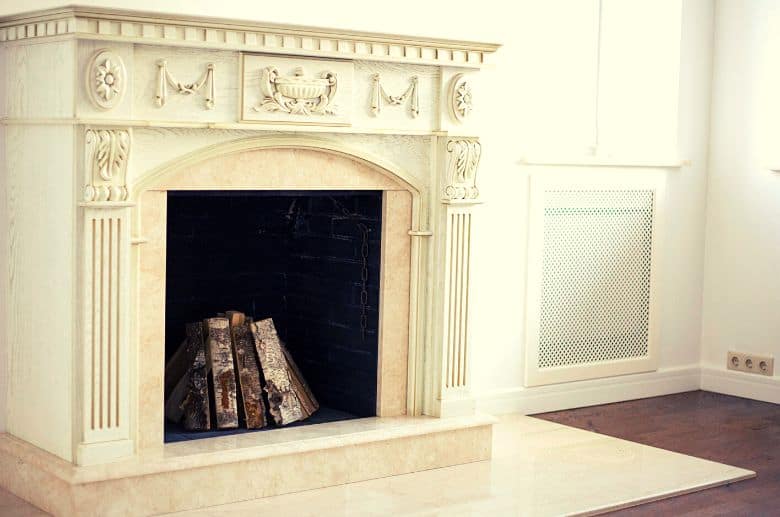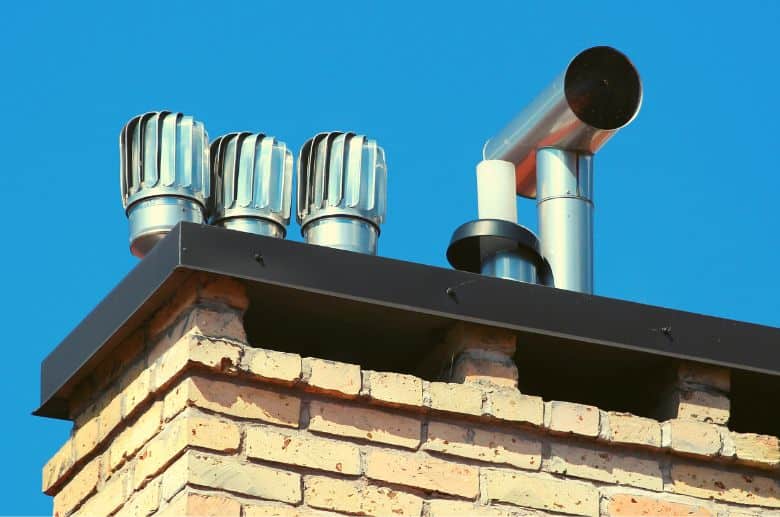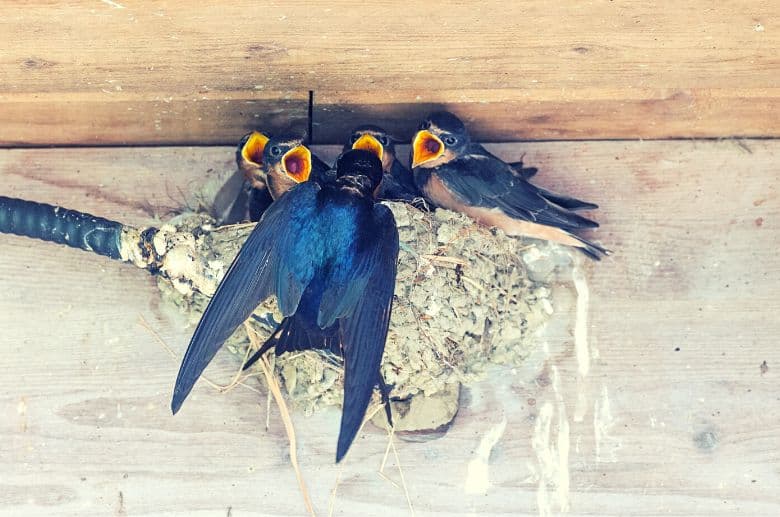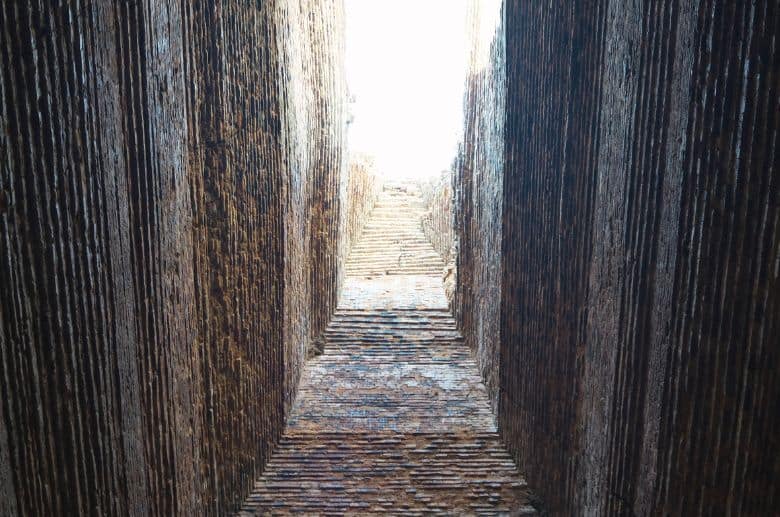As the weather gets warmer and days get longer, Many homeowners wonder if they should leave their fireplace damper open or closed in summer.
Keeping your fireplace damper closed prevents hot, outside air from entering your home.
That is why keeping it closed during the summer is a good idea. A closed damper will prevent hot and humid air from outside and increase your cooling system’s efficiency.
You should keep your fireplace flue open during summer for several reasons. We’ll discuss all these in this article. But first, let’s talk about flue dampers.
What Is a Damper and How Does It Work?
The damper is a metal door that helps control the air flow inside your chimney. Your damper should remain open while the chimney is functional, allowing smoke and other exhaust products to vent. If your damper remains closed while the fire is burning, smoke and other exhaust gasses will enter your room.
But your damper should remain closed when the chimney is not in use.
Depending on the type of damper installed, you can manually open or close a chimney damper using a knob, metallic cable, or any other mechanism.
There are two main types of dampers, as follows:
Throat Dampers
Common in older chimneys, the throat damper is located at the ‘throat of the chimney’, i.e. just above the fireplace. If you place your hand inside the fireplace, behind the fireplace lintel, you’ll be able to touch a steel (or cast iron) plate. This is, essentially, your damper.
You can open or close a throat damper using a rod or a knob located by the fireplace wall. A throat damper swings down and shuts your chimney throat when you close it.
These dampers tend to wrap over time because of the heat from the fireplace.
Top-Sealing Dampers
Top-sealing dampers are located at the top of the chimney, where the chimney cap is installed. These dampers usually use a spring-back functionality and can be operated using a stainless steel cable found by the fireplace.
Top-sealing dampers come with a rubber gasket that helps make a tight seal. This makes them more efficient. These dampers are also more durable since they are not affected by a burning fire.
When to Open and Close the Damper on a Fireplace?

Always open your damper before starting a fire. The fireplace should remain open to allow exhaust gasses such as smoke and Carbon Monoxide (CO) to vent out. If the damper is closed when the fire runs, smoke and other harmful gasses will fill your room. This can lead to coughing, irritation, and various respiratory issues.
Don’t forget to close the damper when your fireplace is not in use. If the damper remains open when the fire is out, all the heat will dissipate. This reduces the efficiency of your fireplace. You’ll have to burn more fuel to keep your house warm and pay hefty energy bills.
Note: Sometimes, little embers remain in the ashes that can produce smoke. Always brush the ashes to extinguish any live embers before closing the damper.
——
Do You Need to Hire Chimney & Fireplace Expert?
Get free quotes from qualified experts near you. No commitment required!
——
Benefits of Keeping Your Fireplace Flue Damper Closed in the Summer
Homeowners are usually confused about whether to keep their dampers open or closed in the summer. That’s because of a myth that an open damper allows hot air to flow out of your chimney in the summer. The truth, however, is the opposite.
But don’t worry the following benefits will remove any doubts you have about keeping your fireplace flue damper closed in the summer.
Hot Air Prevention

When your fireplace and chimney are not in use in summer, having a closed damper can keep your house cool. That’s because an open damper in the summer allows hot air from outside to enter your home or building. This can reverse the cooling effect of your cooling system and make your house warmer.
A closed damper prevents hot air from entering your house, thus, keeping your house cool.
Increased Efficiency
When your damper is open, it allows hot air from outside to come into your home, making it harder for your air conditioner to keep things cool. Your cooling system will have to work harder to maintain the inside temperature. You’ll have to pay more energy bills.
Keeping your fireplace damper closed can prevent hot air from entering. This will significantly increase the efficiency of your cooling system and reduce your energy bills.
Keeping Animals Out

Homeowners often forget about their fireplaces and chimneys in the summer. This neglect can lead to various issues going unnoticed.
For example, your chimney cap might be damaged or have flown away by a strong gust of wind during winter. This will allow animals like birds, bats, squirrels, and raccoons to enter and nest in your chimney in search of shelter. From there, they can find their way into your home.
These animals can wreak havoc inside your house, ruin furniture, tear out your curtains, and destroy your carpets and sofas. Raccoons are particularly notorious.
The good news is that you can avoid this from happening by keeping your damper closed. Even if animals get inside your chimney, they won’t be able to enter your home.
Note: Always have a chimney expert thoroughly inspect your chimney in the fall so that any issues can be fixed before you start burning fires in the winter season. This helps ensure that your chimney is in optimum condition and safe to use. It’s also good to have an inspection in Spring after your chimney has gone through rigorous use in the winter months.
Prevent Weird Fireplace Smells
A chimney that hasn’t been used in months is sure to have foul smells, especially if there are large soot and creosote deposits. These smells resemble charcoal or mothballs. An open chimney damper not only brings hot air but also foul smells. The hot air can also bring dust and debris stuck inside the chimney can ruin your room.
A closed fireplace damper prevents foul chimney smells and debris.
——
Do You Need to Hire Chimney & Fireplace Expert?
Get free quotes from qualified experts near you. No commitment required!
——
How to Tell if Your Chimney Flue Damper Is Open or Closed?

It’s important to know whether your damper is open or closed. You can do this in mainly three ways:
- Place your hand inside the fireplace, if you notice the wind coming down, your damper is open. If not, your damper is closed.
- Place your head inside your fireplace and look up to visually inspect the damper. If you’ve got a throat damper, you’ll see a metal plate blocking your view if your damper is closed. However, if you can see outside, your damper is open. This does not work for top-mounted dampers.
- Check the damper controls (most accurate)
How to Open Your Flue Damper?
Now that you know that you should always open your damper before igniting a fire in your fireplace, it is time to learn how. Follow the step-by-step process to open your flue damper:
Check for controls by the fireplace.
Throat Damper
If you look inside your fireplace, you’ll find either a knob or a rod for your damper system. The knob is usually present above the firebox. If your damper has a rod, it’ll be at the front face of your fireplace.
If your damper has a knob
- If the knob is turned counterclockwise, that means your damper is closed.
- To open the damper, simply turn the knob clockwise as far as possible.
If your damper has a rod
- If the rod is hanging low, you’ve got a closed damper.
- To open the damper, push the rod upwards.
Top-Sealing Damper
- If you’ve got a top-sealing damper, you will find a metal chain by the fireplace.
- Your damper is closed if the chain is tightly attached to a hook.
- To open your top-sealing damper, unhook the chain and let the chain pull upwards until it stops, then attach it to the hook.
How to Close Your Damper?
Your flue damper should remain closed when your chimney is not in use. If you don’t know how to close your damper, follow this step-by-step guide:
Throat Damper
- If your knob is turned clockwise, your damper is open.
- To close a throat damper, turn the knob counterclockwise.
- Your damper is open if you’ve got a rod in the upward direction.
- To close it, simply pull the rod down.
Top-Sealing Damper
- Your damper is open if the chain is loosely attached to the hook.
- To close your top-sealing damper, unhook the chain and pull the chain downwards until it is tight, then attach it to the hook.
Can You Partially Close the Damper on a Fireplace?
Theoretically, you can partially open or close your damper. However, you should never partially close a damper during an active fire. Doing this will reduce the space for the smoke to go out. Some of the smoke and other harmful gasses e.g. Carbon Monoxide, enter your home. These gasses cause respiratory issues, especially in elders and children. In extreme cases, CO can even be fatal.
If you fully closed your damper, but the air is still coming inside, that means there’s some problem with your damper. You might need to get it replaced by a chimney expert. On the other hand, if your damper is open but smoke is still getting inside your room, that means there’s a clogging issue. Call a professional chimney sweep to inspect and resolve the issue.
The Takeaway
During summers, your fireplace damper needs to be closed to prevent hot air from getting inside. A closed damper will save energy bills by increasing the efficiency of your cooling system.
But you should always remember, if the fire is burning inside your fireplace, your damper should be open to allow smoke to vent outside.
Make sure that your damper is working optimally. If it is not opening or closing fully, get it checked and/or replaced by a chimney expert.






